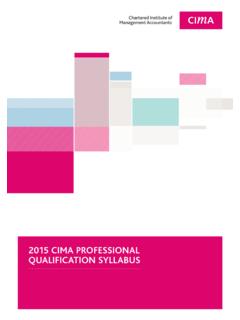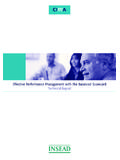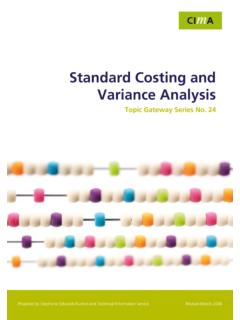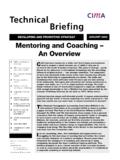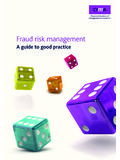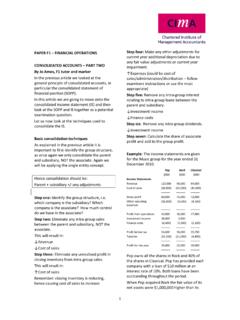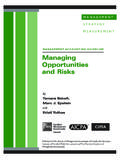Transcription of 2019 CIMA Professional Qualification Syllabus
1 Reinventing finance in a digital world2019 CIMA Professional Qualification Syllabus 32 Foreword3 Contents4 The CIMA Professional Qualification5 The CIMA Qualification Framework6 The CGMA Competency Framework8 Structure of the CIMA Syllabus10 Learning outcomes and Exam blueprints12 CIMA assessment strategy12 Suggested order of exams14 The Syllabus in the context of the finance function15 Summary of the 2019 Syllabus16 The Operational Level20 E1: Managing Finance in a Digital World32 P1: Management Accounting42 F1: Financial Reporting52 The Management Level 56 E2: Managing Performance64 P2: Advanced Management Accounting74 F2: Advanced Financial Reporting86 The Strategic Level 90 E3: Strategic Management104 P3: Risk Management114 F3: Financial Strategy124 Exam information and timetableContents ChallengesPerformanceMindset and competenciesLearning systemsRealise the challenges organisations face which threaten their successComprehend the performance needed from the finance team to address those challenges Understand the competencies and mindset needed to perform at the required level Use learning to continually update their competencies and maintain a flexible mindset for new challengesIncreasingly, the required skills of finance professionals are moving into the expert, problem-solving arena and they must adopt competencies involved in influencing and change management.
2 The finance Professional needs a mindset that enables them to adapt through continuous learning. They must ..I am pleased to introduce the 2019 CIMA Professional Qualification Syllabus , which further strengthens our commitment to the employability needs of both business and people, and underpins the CGMA an increasingly digital world, rapid changes in technology are creating challenges for the business models of organisations. It is also making it difficult for business leaders and employees to create and preserve sustainable value. Against this digital backdrop, it is imperative that finance professionals possess relevant technical skills, a sound understanding of their organisation, as well as the ability to influence and lead people. This will make them capable of providing the insight their organisations need to craft and successfully execute their 2019 Syllabus continues to bridge the skills gap of newly qualified finance professionals worldwide, meeting the employability needs of both business and people.
3 In designing the Syllabus , we set out to enhance the relevance of the Syllabus to employers; ensure the rigour of the related examinations and align the learning experience of candidates to the real changes in the Syllabus are based on our three-stage research approach of employer interviews, roundtables and a global survey to a range of stakeholders. We contacted over 6,500 finance professionals, from over 2,000 organisations, in over 150 countries. We have used the same research methodology as the previous Syllabus update but on a larger scale and with wider participation. This research has allowed us to capture the latest views of finance professionals so that we can incorporate these into the , the updated Syllabus includes how the digital world affects finance; this can be seen through the introduction of digital costing and digital strategy. Topics such as cybersecurity and business models have also been incorporated.
4 Existing areas, such as integrated reporting, have been expanded to reflect their growing prominence. Ultimately, these topics support CIMA s desire to produce competent and confident management accounting professionals who can guide and lead their organisations to sustainable strongly recommend the CIMA Professional Qualification to employers and to those wishing to pursue a successful and rewarding career in Tagoe, , FCMA, CGMA Executive Vice President MA Research and CurriculaForeword D igitalisation is transforming all industries. This is why digital skills should be conveyed at all levels and in all forms of education. Joe Kaeser, President and CEO Siemens AG2 CIMA Professional Qualification Syllabus4 CIMA Professional Qualification Syllabus5 The CIMA Professional Qualification CIMA s objective in designing the Syllabus is to enhance the employability of students and members.
5 It intends to create a learning system that enables learners to acquire skills, competencies and mindsets that are in high demand by employers. This has never been more important with the pace of change increasing and traditional roles being redefined by technology and digital Professional Qualification comprises three pillars of domain knowledge divided into three levels of achievement. The pillars are Enterprise, Performance and Financial. The levels are Operational, Management and Strategic. When combined with the required practical experience, CIMA qualified members will be capable of supporting and leading their organisations through the challenging environment of constant change. The Syllabus , assessments and practical experience requirements ensure members are competent in the essential accounting, finance and business-related skills. It also provides them with the skills required to lead the finance function in a digital complete the CIMA Qualification , and be able to use the Chartered Global Management Accountant (CGMA ) designation, students need to: Meet the entry requirements of the Professional level Qualification .
6 Study for and complete the relevant Professional level assessments, culminating in the Strategic Case Study Exam. Complete three years of relevant practical experience, which can be gained before, during and/or after CIMA Qualification FrameworkThe diagram below shows the CIMA Qualification Framework. This includes the Certificate in Business Accounting; the Professional Qualification ; Assessment of Practical Experience; and Continuing Professional Development (CPD) in the form of lifelong : CIMA Advanced Diploma in Management Accounting (CIMA Adv Dip MA)AWARD: CIMA Diploma in Management Accounting (CIMA Dip MA)AWARD: CIMA Certificate in Business Accounting (CIMA Cert BA)Practical experience / lifelong learningEnterprise pillarB A1 Fundamentals of Business EconomicsE1 Managing Finance in a Digital WorldE2 Managing PerformanceE3 Strategic ManagementBA2 Fundamentals of Management AccountingP1 Management AccountingP2 Advanced Management AccountingP3 Risk ManagementBA3 Fundamentals of Financial AccountingF1 Financial ReportingF2 Advanced Financial ReportingF3 Financial StrategyManagement Level Strategic Level Operational Level Certificate Level Performance pillarFinancial pillarAssessment of practical experience requirements (PER)Strategic Case Study ExamManagement Case Study ExamOperational Case Study ExamAWARD.
7 Membership of the Chartered Institute of Management Accountants (ACMA/FCMA) and the CGMA designationBA4 Fundamentals of ethics , corporate governance and Business Law6 CIMA Professional Qualification Syllabus7 The CGMA Competency Framework The CGMA Competency Framework was first introduced with the 2015 Syllabus . It set out the skills and competencies that employers identified as essential for their finance staff across a range of industries, organisation sizes and role levels within an organisation. To update both the Syllabus and competency framework, we once again undertook global research to better understand what is changing for both the finance function within the organisation and the finance Professional , against the backdrop of an ever-increasing digital three-stage research approach of employer interviews, roundtables and a global survey to a range of stakeholders, meant that we reached out to over 6,500 finance professionals, from over 2,000 organisations, in over 150 countries, to answer the following questions; H ow will the future be different for your organisation?
8 W hat are the drivers of change for your organisation? What are the implications for finance? How should finance prepare for the changes?The digital world, in which organisations now operate, is changing rapidly and in unpredictable ways. Our research shows that technology is seen as the key driver of change for both organisations and their finance functions. Technology is transforming what finance professionals do, and revolutionising how the finance function is being deployed. The competency framework reflects our findings on how finance professionals are expected to apply accounting and finance skills within the context of the business/organisations in which they operate. It also reflects for the first time how technology and a digital mindset will be required to affect and influence their own decisions, actions and behaviours and those of their colleagues within the wider organisation.
9 To be able to do this, five sets of skills have been identified technical accounting and finance skills; business skills; people skills; leadership skills and digital skills and a digital mindset underpinning the categories. The knowledge, skills and behaviours within each area of the CGMA Competency Framework knowledge areas are:Technical skillsFinancial accounting and reporting; cost accounting and management; business planning; management reporting and analysis; corporate finance and treasury management; risk management and internal control; accounting information systems; and tax strategy, planning and skillsStrategy; business models; market and regulatory environment; process management; business relations; business ecosystems management; project management; and macroeconomic skillsInfluence; negotiation and decision-making, communication; and collaboration and skillsTeam building; coaching and mentoring; driving performance; change management; and ability to motivate and inspire.
10 Digital skillsInformation and digital literacy; digital content creation; problem-solving; data strategy and planning; data analytics; and data remain underpinned by ethics , integrity and on the survey responses, the graph below shows the activities in which respondents currently spend their time, depending on their role within the organisation. It is anticipated that these will alter as technology and digitalisation continue to affect the role of the finance skillsTe c h n i c a l skillsBusiness skillsLeadership skillsPeople skills50454035302520151050 Entry levelPoints (0 to 100) represent time spent on activities in each knowledge held within the organisationManagerSenior managerCFOT echnical accountingBusinessPeopleLeadership8 CIMA Professional Qualification Syllabus9 Structure of the CIMA SyllabusThe CIMA Syllabus comprises nine subjects that are organised in three pillars and three pillarsThe three pillars represent specific areas of content of each pillar develops as students move up the Qualification .
